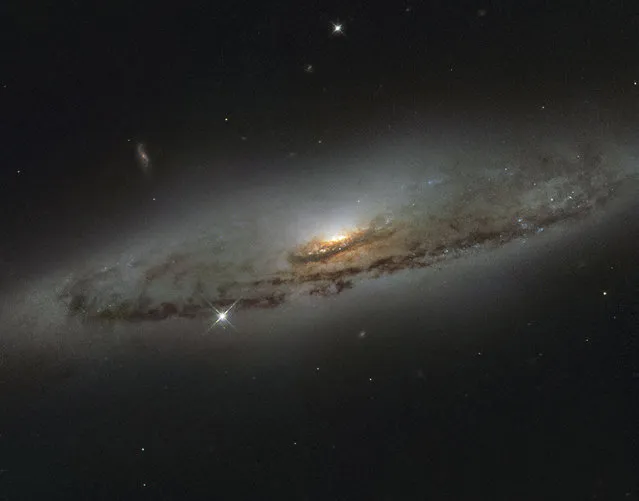
The spiral galaxy NGC 4845, located over 65 million light-years away in the constellation of Virgo (The Virgin) is shown in this NASA/ESA Hubble Space Telescope image released on January 8, 2016. The galaxy's orientation clearly reveals the galaxy's striking spiral structure: a flat and dust-mottled disc surrounding a bright galactic bulge. NGC 4845's glowing center hosts a gigantic version of a black hole, known as a supermassive black hole. (Photo by Reuters/NASA)
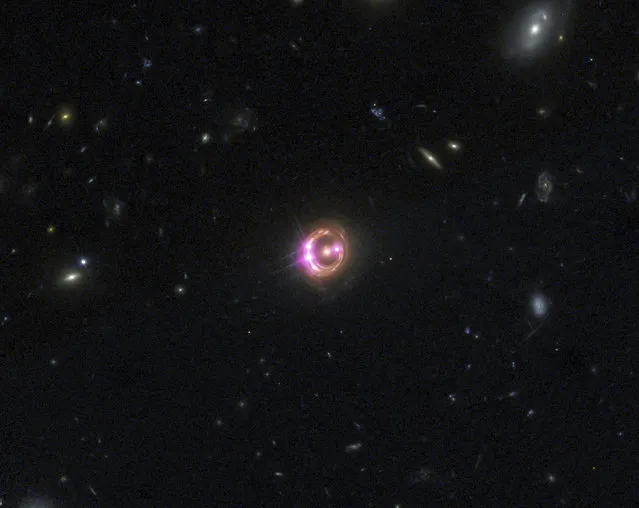
Multiple images of a distant quasar are visible in this undated combined view from NASAís Chandra X-ray Observatory and the Hubble Space Telescope. For the first time, scientists have measured the spin of a distant supermassive black hole and found that its rate of rotation is about 3.5 trillion mph – roughly half the speed of light. The finding provides insights into how the black hole and its host galaxy formed. (Photo by Reuters/NASA)
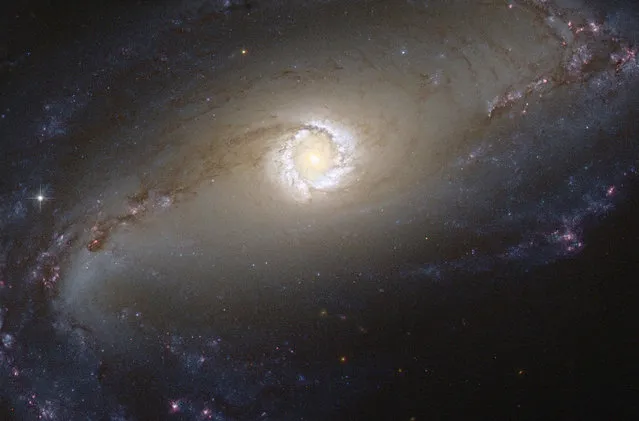
This NASA/ESA Hubble Space Telescope image shows the bright star-forming ring that surrounds the heart of the barred spiral galaxy NGC 1097, a Seyfert galaxy. The larger-scale structure of the galaxy is barely visible. Its comparatively dim spiral arms, which surround its heart in a loose embrace, reach out beyond the edges of this frame. This face-on galaxy, lying 45 million light-years away from Earth in the southern constellation of Fornax (The Furnace), is particularly attractive for astronomers. Lurking at the very centre of the galaxy, a supermassive black hole 100 million times the mass of our Sun is gradually sucking in the matter around it. The area immediately around the black hole shines powerfully with radiation coming from the material falling in. The distinctive ring around the black hole is bursting with new star formation due to an inflow of material toward the central bar of the galaxy. These star-forming regions are glowing brightly thanks to emission from clouds of ionised hydrogen. The ring is around 5000 light-years across, although the spiral arms of the galaxy extend tens of thousands of light-years beyond it. (Photo by Reuters/NASA/ESA)
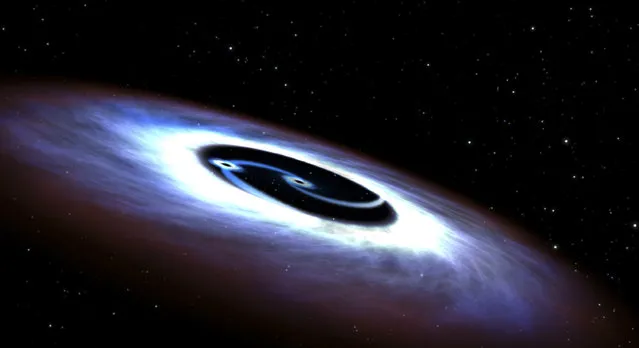
Markarian 231, a binary black hole found in the center of the nearest quasar host galaxy to Earth, is seen in a NASA illustration released August 27, 2015. Like a pair of whirling skaters, the black-hole duo generates tremendous amounts of energy that makes the core of the host galaxy outshine the glow of the galaxy's population of billions of stars, according to a NASA news release. Hubble observations of the ultraviolet light emitted from the nucleus of the galaxy were used to deduce the geometry of the disk, and astronomers were surprised to see light diminishing close to the central black hole, said NASA. (Photo by Reuters/NASA)
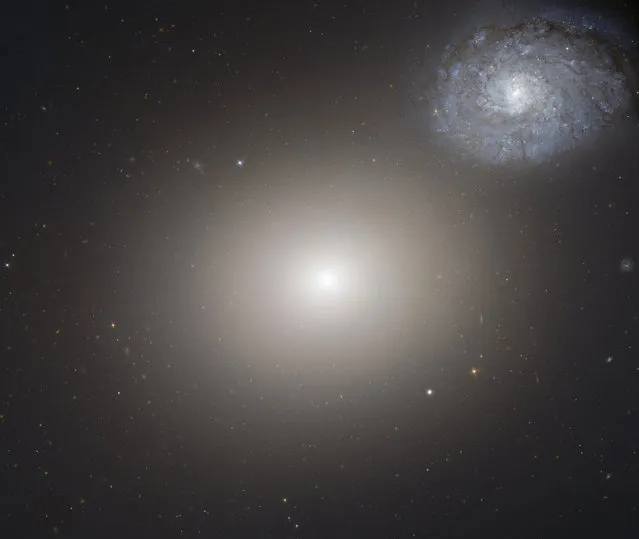
NASA's Hubble Space Telescope image shows two very different galaxies drifting through space together in this image released on September 6, 2012. The peculiar galaxy pair is called Arp 116 which is composed of a giant elliptical galaxy known as Messier 60 or M60 (C) and a much smaller spiral galaxy, NGC 4647 (upper right). M60 is the third brightest galaxy in the Virgo cluster of galaxies, a collection of more than 1,300 galaxies. M60 has a diameter of 120,000 light-years and a mass of about one trillion times that of the Sun. A huge black hole of 4.5 billion solar masses lies at its center, one of the most massive black holes ever found. The faint bluish spiral galaxy NGC 4647 is about two-thirds of M60 in size and much lower in mass – roughly the size of our galaxy, the Milky Way. M60 lies roughly 54 million light-years away from Earth; NGC 4647 is about 63 million light-years away. (Photo by Reuters/NASA/ESA/Hubble Heritage)
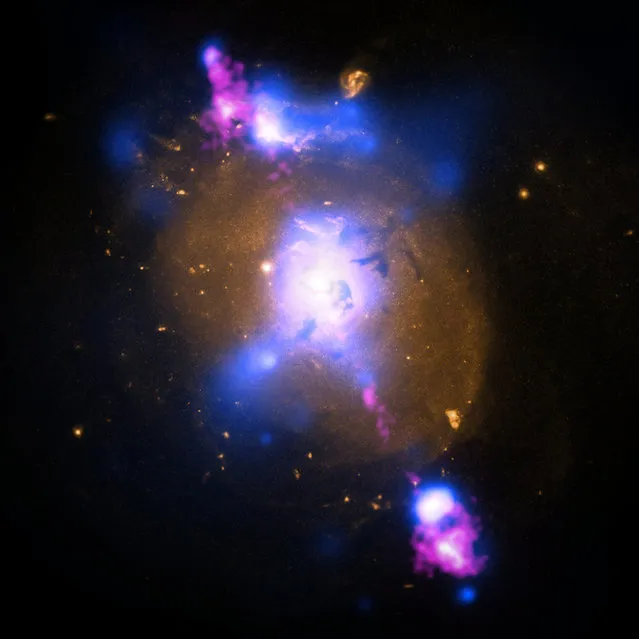
A composite image of a galaxy illustrating how the intense gravity of a supermassive black hole can be tapped to generate immense power is shown in this handout photo released by NASA May 15, 2013. The image contains X-ray data from NASA's Chandra X-ray Observatory (blue), optical light obtained with the Hubble Space Telescope (gold) and radio waves from the NSFís Very Large Array (pink). This multi-wavelength view shows 4C+29.30, a galaxy located some 850 million light years from Earth. The radio emission comes from two jets of particles that are speeding at millions of miles per hour away from a supermassive black hole at the center of the galaxy. The estimated mass of the black hole is about 100 million times the mass of our Sun according to NASA. (Photo by Reuters/NASA)
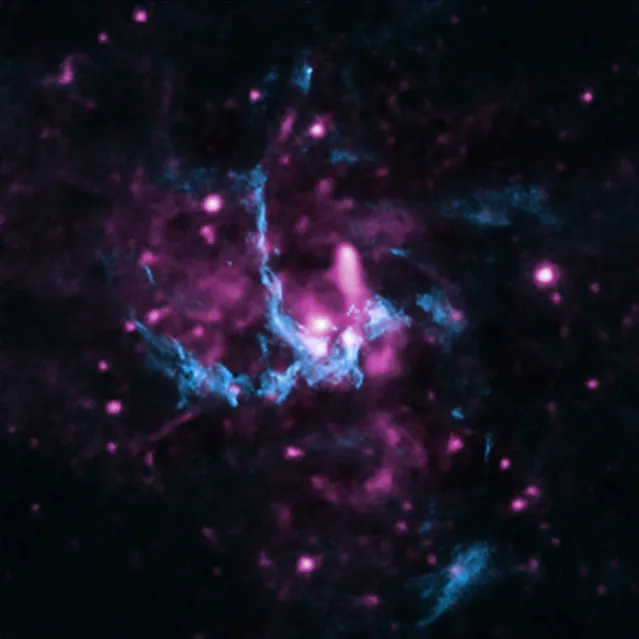
A NASA composite image, featuring both X-ray data from NASA's Chandra X-ray Observatory with radio emission from the NSF's Very Large Array (VLA) released on November 20, 2013 shows new evidence that has been uncovered for the presence of a jet of high-energy particles blasting out of the Milky Way's supermassive black hole. Astronomers have been looking for a jet from Sgr A* for years since it is now common to find jets tied to a range of cosmic objects on both big and small scales. Prior to this latest study, there have been reports of possible evidence of a jet associated with Sgr A*. (Photo by Reuters/NASA/CXC/UCLA/Z. Li et al; Radio: NRAO/VLA)
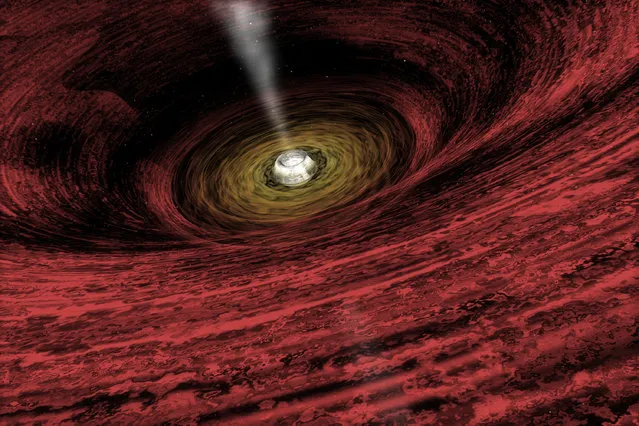
An artist's impression of a growing supermassive black hole located in the early Universe is seen in this NASA handout illustration released on June 15, 2011. Using the deepest X-ray image ever taken, astronomers found the first direct evidence that massive black holes were common in the early universe. This discovery from NASA's Chandra X-Ray Observatory shows that very young black holes grew more aggressively than previously thought, in tandem with the growth of their host galaxies. (Photo by Reuters/NASA/Chandra X-Ray Observatory/A.Hobart)
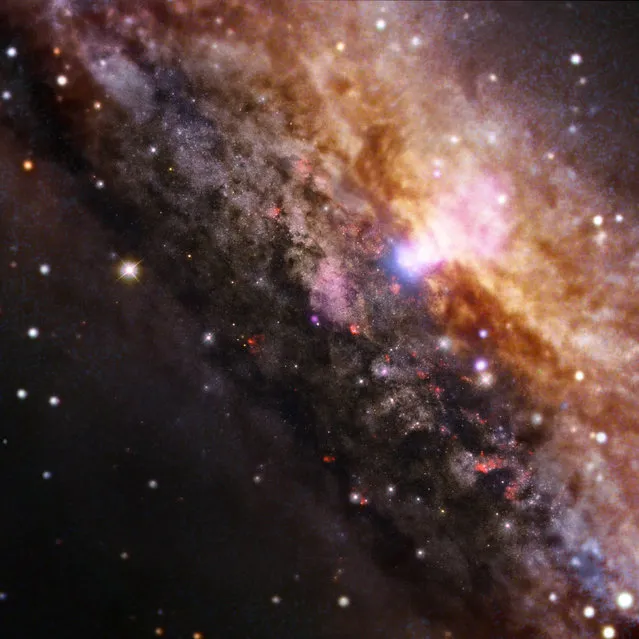
Galaxy NGC 4945 is shown in this NASA handout image provided on November 4, 2013. The galaxy is similar in overall appearance to our own Milky Way, but contains a much more active supermassive black hole within the white area near the top. Approximately 13 million light years from earth, X-rays from Chandra (blue), which have been overlaid on an optical image from the European Space Observatory (ESO), reveal the presence of the supermassive black hole at the centre of this galaxy. (Photo by Reuters/NASA/CXC/Univ degli Studi Roma Tre/A.Marinucci et al/ESO/VLT & NASA/STScI)
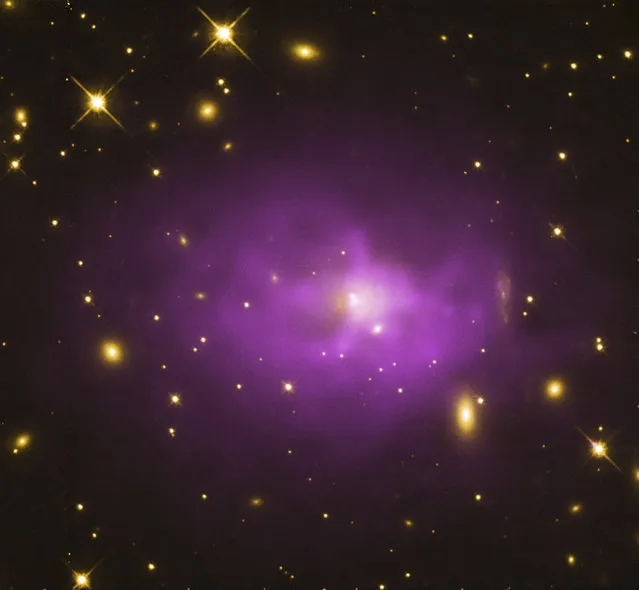
The galaxy cluster PKS 0745-19 is shown in this NASA composite image containing X-rays from Chandra (purple) and optical date from the Hubble Telescope (yellow) released December 19, 2012. The black hole at the center of this galaxy is part of a survey of 18 of the biggest known black holes in the universe. Researchers found that the black holes in the survey may be about ten times more massive than previously thought. (Photo by Reuters/NASA/CXC/Stanford)
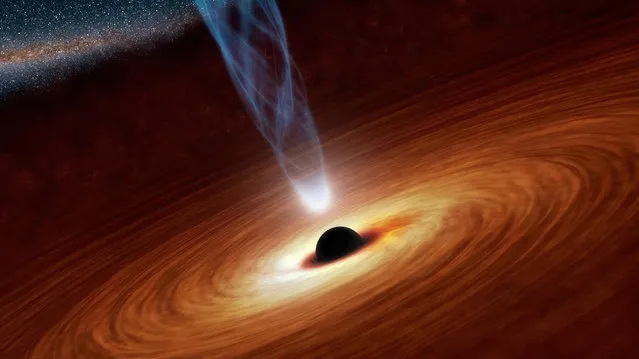
An artist's illustration shows a supermassive black hole with millions to billions times the mass of our sun at the center, surrounded by matter flowing onto the black hole in what is termed an accretion disk in this NASA illustration released on February 27, 2013. Supermassive black holes are enormously dense objects buried at the hearts of galaxies. This disk forms as the dust and gas in the galaxy falls onto the hole, attracted by its gravity. (Photo by Reuters/NASA/JPL-Caltech)
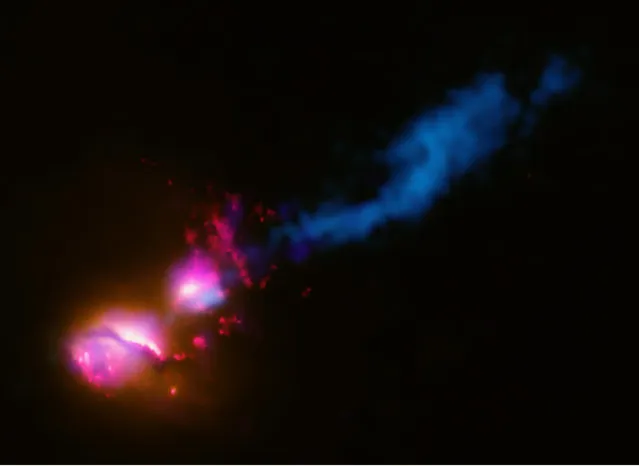
This composite image shows the jet from a black hole at the center of a galaxy striking the edge of another galaxy, the first time such an interaction has been found. In the image, data from several wavelengths have been combined. X-rays from Chandra (colored purple), optical and ultraviolet (UV) data from Hubble (red and orange), and radio emission from the Very Large Array (VLA) and MERLIN (blue) show how the jet from the main galaxy on the lower left is striking its companion galaxy to the upper right. The jet impacts the companion galaxy at its edge and is then disrupted and deflected, much like how a stream of water from a hose will splay out after hitting a wall at an angle. (Photo by Reuters/NASA/CXC/CfA/D.Evans)
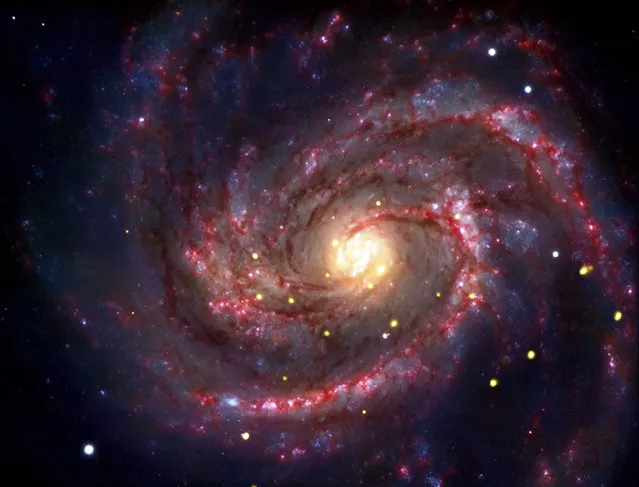
A supernova within the galaxy M100, that may contain the youngest known black hole in our cosmic neighborhood, is seen in this composite image released to Reuters November 15, 2010, Chandra's X-rays are colored gold, while optical data from ESO's Very Large Telescope are shown in yellow-white and blue, and infrared data from Spitzer are red. Earth's newest neighbor, a supernova spotted 30 years ago, appears to be a newborn black hole, astronomers reported on Monday. X-ray observations suggest the object, a mere 50 million light-years away in a neighboring galaxy, is a black hole in the making, the team of U.S. and European astronomers said. (Photo by Reuters/Chandra X-ray Observatory Center)
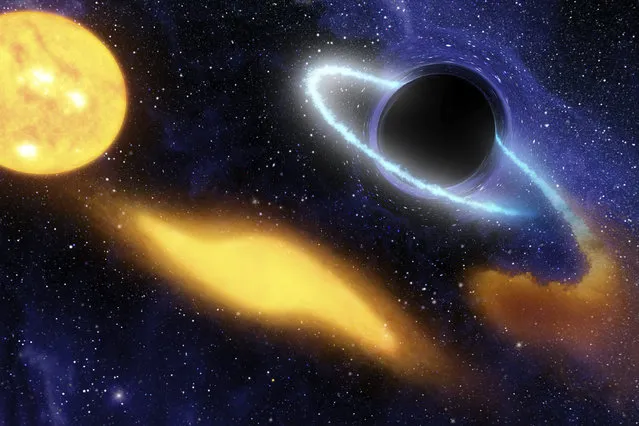
The artist's concept chronicles the star being ripped apart and swallowed by the cosmic beast over time. First, the intact sun-like star (left) ventures too close to the black hole, and its own self-gravity is overwhelmed by the black hole's gravity. The star then stretches apart (middle yellow blob) and eventually breaks into stellar crumbs, some of which swirl into the black hole (cloudy ring at right). This doomed material heats up and radiates light, including ultraviolet light, before disappearing forever into the black hole. The Galaxy Evolution Explorer was able to watch this process unfold by observing changes in ultraviolet light. The area around the black hole appears warped because the gravity of the black hole acts like a lens, twisting and distorting light. (Photo by Reuters/NASA/JPL-Caltech)
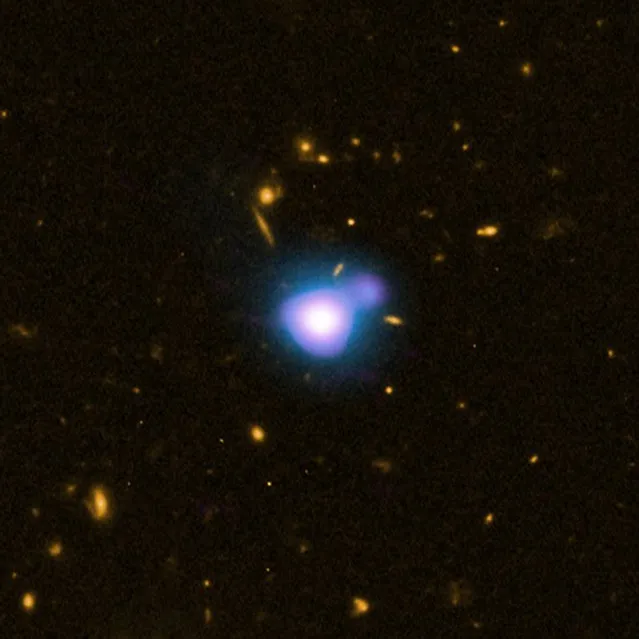
Undated composite image courtesy of NASA shows the most distant X-ray jet from a quasar named GB 1428+4217 located 12.4 billion light years from Earth. X-ray data from NASA's Chandra X-ray Observatory is shown in blue, radio data from the NSF's Very Large Array are shown in purple and optical data from NASA's Hubble Space Telescope are shown in yellow. Giant black holes at the centers of galaxies can pull in matter at a rapid rate producing the quasar phenomenon. The researchers believe the length of the jet in GB 1428 is at least 230,000 light years, or about twice the diameter of the entire Milky Way galaxy. (Photo by Reuters/NASA/CXC/NRC/C.Cheung et al/STScI/NSF/NRAO/VLA)
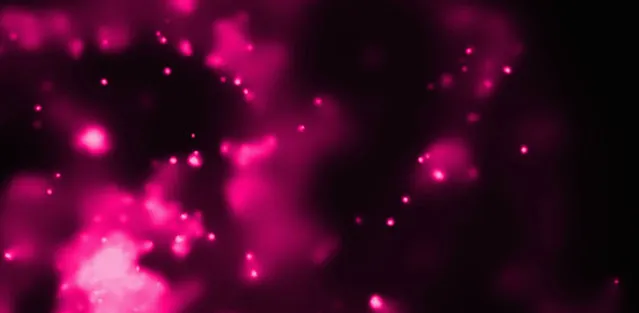
NASA's Chandra X-ray Observatory image of an extraordinary outburst by a black hole in the spiral galaxy M83, located about 15 million light years from Earth, is shown in this handout released July 13, 2012. Using Chandra, astronomers found a new ultraluminous X-ray source, or ULX. These objects give off more X-rays than most normal binary systems in which a companion star is in orbit around a neutron star or black hole. (Photo by Reuters/NASA/CXC/Curtin University/R.Soria et al)
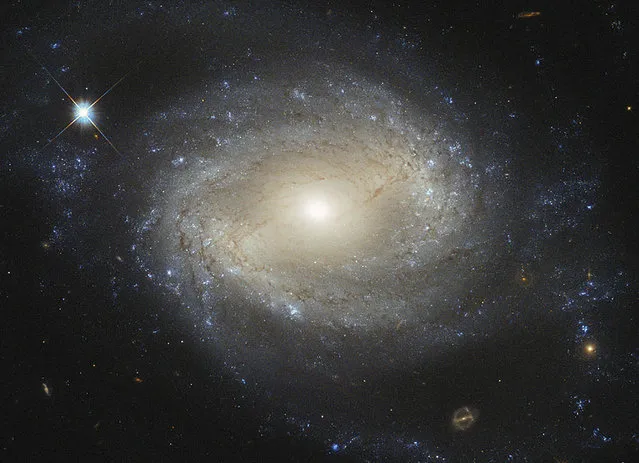
The barred spiral galaxy NGC 4639 is seen in an undated image taken by the NASA/ESA Hubble Space Telescope, released October 16, 2015. NGC 4639 lies over 70 million light-years away in the constellation of?Virgo and is one of about 1500 galaxies that make up the Virgo Cluster. NGC 4639 also conceals a massive black hole that is consuming the surrounding gas, according to a NASA news release. (Photo by Reuters/NASA/ESA/Hubble)
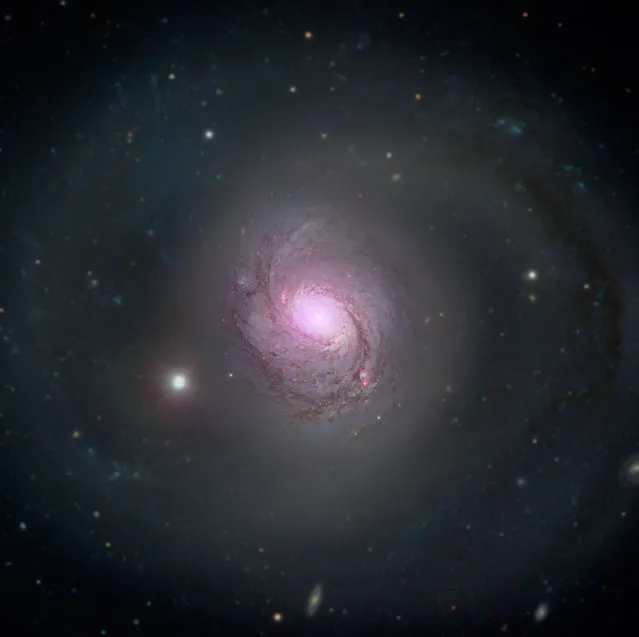
Galaxy 1068 located about 47 million light-years away in the constellation Cetus is shown in visible light and X-rays in this NASA composite image released on December 17, 2015. High-energy X-rays (magenta) captured by NASA's Nuclear Spectroscopic Telescope Array, or NuSTAR, are overlaid on visible-light images from both NASA's Hubble Space Telescope and the Sloan Digital Sky Survey. The X-ray light is coming from an active supermassive black hole, also known as a quasar, in the center of the galaxy. This supermassive black hole has been extensively studied due to its relatively close proximity to our galaxy. (Photo by Reuters/NASA/JPL-Caltech/Roma Tre Univ)
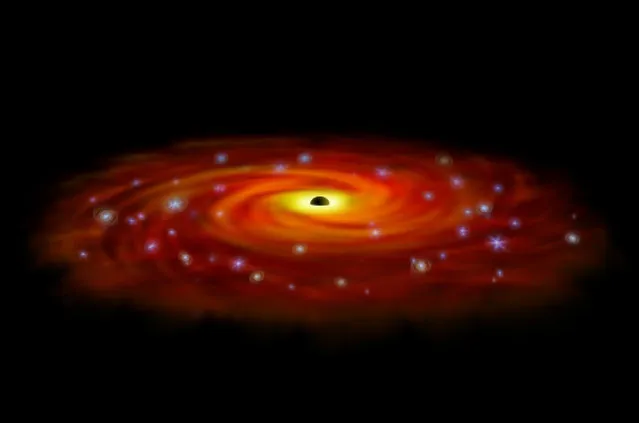
The ring of stars circling Sagittarius A*, the Milky Way's central black hole, shows a combination of infrared and X-ray observations indicating that a surplus of massive stars has formed from a large disk of gas around the black hole in this artist's concept released October 13, 2005. Dozens of massive stars, destined for a short but brilliant life, were born less than a light-year away from the Milky Way's central black hole, one of the most hostile environments in our galaxy, astronomers reported October 13, 2005. (Photo by Reuters/NASA/CXC/M. Weiss)
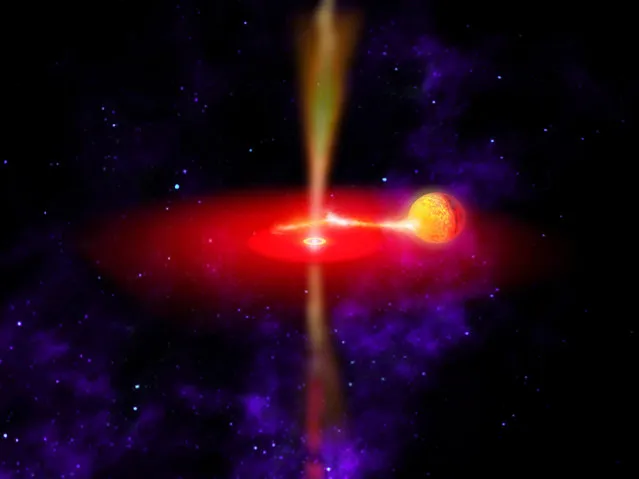
An artist's concept illustrates what the flaring black hole called GX 339-4 might look like in this NASA handout image. Infrared observations from NASA's Wide-field Infrared Survey Explorer (WISE) reveal the best information yet on the chaotic and extreme environments of this black hole's jets. GX 339-4 likely formed from a star that exploded. It is surrounded by an accretion disk (red) of material being pulled onto the black hole from a neighboring star (yellow orb). Some of this material is shot away in the form of jets (yellow flows above and below the disk). The region close in to the black hole glows brightly in infrared light. (Photo by Reuters/NASA/JPL)
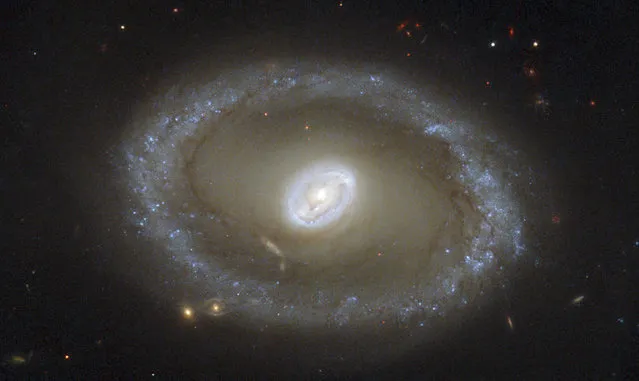
A galaxy known as NGC 3081 located over 86 million light-years from Earth is seen in an undated NASA/ESA Hubble Space Telescope image taken using the Wide Field Planetary Camera 2. The galaxy's barred spiral center is surrounded by a bright loop known as a resonance ring. This ring is full of bright clusters and bursts of new star formation, and frames the supermassive black hole thought to be lurking within NGC 3081 – which glows brightly as it hungrily gobbles up in-falling material. (Photo by Reuters/NASA/ESA/Hubble)
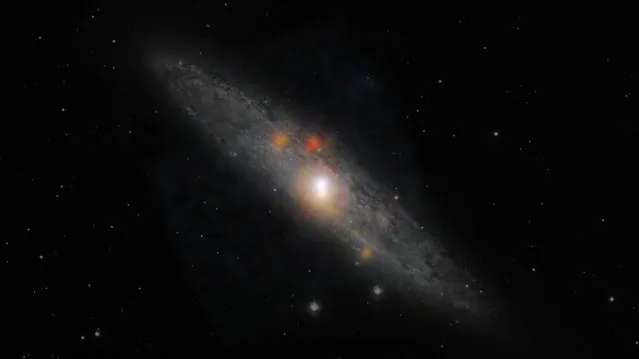
A composite image from NASA's Nuclear Spectroscopic Telescope Array (NuSTAR) and the European Southern Observatory in Chile shows the Sculptor galaxy in this image released June 11, 2013 by NASA. Visible data from the European Space Observatory show the backbone of the galaxy made up of stars, while NuSTAR data, which appear as colored blobs, show high-energy X-rays. The NuSTAR observations are the sharpest ever taken of this galaxy in high-energy X-rays. The findings, when combined with those from NASA's Chandra X-ray Observatory, suggest that the supermassive black hole at the center of the Sculptor galaxy, also known as NGC 253, has dozed off, or gone inactive, sometime in the past decade. (Photo by Reuters/NASA/JPL-Caltech/JHU)
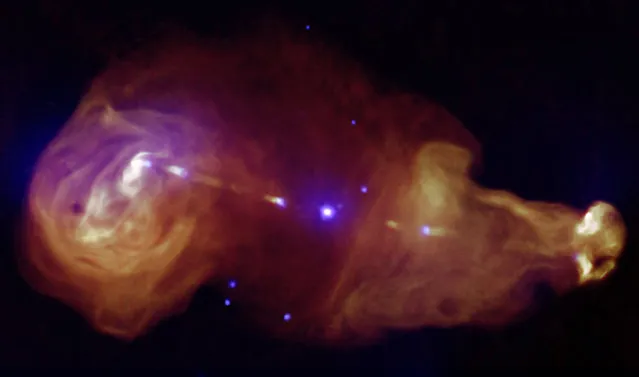
A NASA image shows giant plumes of radiation seen in X-rays from Chandra (purple) and radio data from the Very Large Array (orange) from radio galaxy 3C353, a wide, double-lobed active galaxy that is very luminous at radio wavelengths, where the galaxy is the tiny point in the center in this image released on November 1, 2013. Jets generated by supermassive black holes at the centers of galaxies can transport huge amounts of energy across great distances. (Photo by Reuters/NASA/CXC/Tokyo Institute of Technology/J.Kataoka)
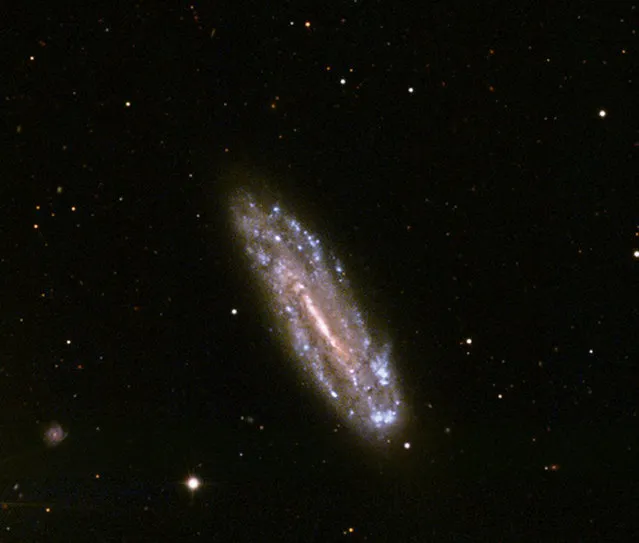
One of the lowest mass supermassive black holes ever observed in the middle of a galaxy located in the middle of the spiral galaxy NGC 4178, is shown in this image from the Sloan Digital Sky Survey released on October 25, 2012. An analysis of the NASA's Chandra X-ray Observatory data, along with infrared data from NASA's Spitzer Space Telescope and radio data from the NSF's Very Large Array suggests that the black hole is near the extreme low-mass end of the supermassive black hole range. NGC 4178 is a spiral galaxy located about 55 million light years from Earth. (Photo by Reuters/NASA/CXC/George Mason Univ)
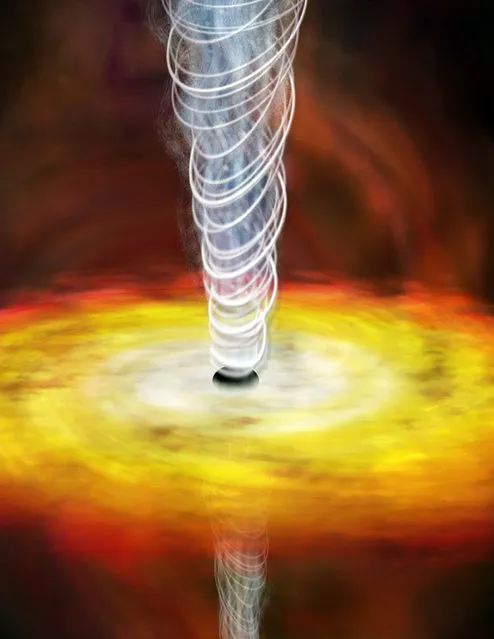
An undated illustration shows an artist's impression of a black hole engine. Black holes are the most fuel-efficient engines in the universe, researchers said on April 24, 2006. If a car could use this kind of engine, it could theoretically go about a billion miles (1.6 billion km) on a gallon (4.5 litres) of gas, said Steve Allen of Stanford University in California. Fueled by matter lured by the holes' vast gravity, most of the energy released by this matter as it gets close to the black hole's point of no return – known as the event horizon – shows up in the form of high-energy jets, which spew forth from magnetized disks of gas. (Photo by Reuters/NASA)
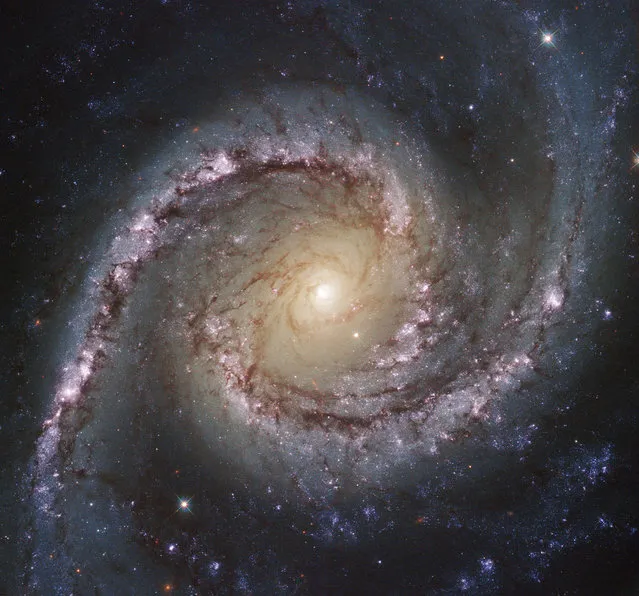
A new undated Hubble image shows NGC 1566, a galaxy located about 40 million light-years away in the constellation of Dorado (The Dolphinfish). According to NASA, the NGC 1566 is an intermediate spiral galaxy. That means while the NGC 1566 does not have a well defined bar-shaped region of stars at its centre, like barred spirals, it is not quite an unbarred spiral either (heic9902o). The small but extremely bright nucleus of the NGC 1566 is clearly visible in this image, a telltale sign of its membership of the Seyfert class of galaxies. The centres of such galaxies are very active and luminous, emitting strong bursts of radiation and potentially harbouring supermassive black holes that are many millions of times the mass of the Sun. NGC 1566 is the second brightest Seyfert galaxy known. It is also the brightest and most dominant member of the Dorado Group, which is a loose concentration of galaxies that collectively comprise one of the richest galaxy groups of the southern hemisphere. The image was taken by Hubble's Wide Field Camera 3 (WFC3) in the near-infrared part of the spectrum. (Photo by Reuters/NASA/ESA)
11 Feb 2016 12:57:00,
post received
0 comments
